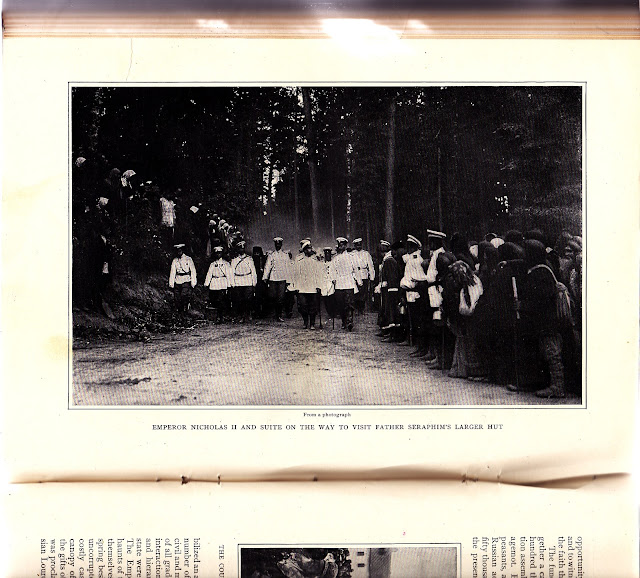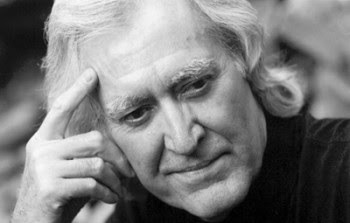Looking for something different to get into today, and was paging through some of those old journal volumes [c.1880s-1910s mostly] which have produced several intriguing topics in the past months. Went through four of them and it was pretty slim pickings this time. The closest thing was an article from The Century, September 1904, entitled “The Russian Lourdes” by David Bell MacGowan.
The article was stimulated by the canonization of a legendary holy person of Sarov, Russia, named St. Seraphim. The “Lourdes” allusion was due to the location having a well and flowing stream with alleged healing properties, attributable to a vision/interaction of Seraphim with the Blessed Virgin, whereupon the stream was formed. To make this make some sort of sense, a thumbnail account of Seraphim’s life is in order.
Seraphim was a pacifist at heart from his early youth and was once beaten so thoroughly by a gang of thugs that he spent his adulthood as a bent hunchbacked cripple. Whether because of this infirmity or probably more so because of his non-violent and spiritual frame of mind, Seraphim entered into the religious life, ultimately achieving status amongst a monastic society near Sarov. For whatever reasons, Seraphim preferred the company of nature to that of humans, and became a hermit.
As his life in solitude went on, apparently Seraphim not only deepened in his devotions to prayer and fasting and attempts to demonstrate his faithfulness to God and the Blessed Virgin, but he began to wake up to the fact that there were other persons about for whom he should be doing some sort of service. Thus Seraphim began a phase of his life which was actually useful [this last sentence is showing my bias against wasting the time you have on Earth doing nothing but avoiding the rest of us regardless of how much self-oriented praying you do]. [Sorry, hermits, but that’s my opinion about excessive “solitude” — get your butts “out there” where there are so many folks needing your help].
Anyway…. Seraphim DID finally “get it” and began admitting folks into his presence, happily even. When he did that, others found a gentle man who had an eery ability to know precisely what was troubling their health [and other matters], who had a concomitant gift of healing. Even then though, it took a vision of Mary wherein she ordered him to quit floundering about doing his own business in the forest, and get out there and minister to people. He was 66 when he finally got moving. Well, better late than never, and Seraphim began “receiving” over 2000 folks a day, as his reputation as a counsellor-healer spread.
Well, we all have our prejudices and I have more than my share [Hey! I’m Catholic! I’m all for Seraphim now that he’s moving, and doing good works. And I’m predisposed to believe that he actually DID do them]. One of my prejudices hints to me that all that “forest time” might not really have been wasted. Excessive maybe. Wasted ? no. This is because there are instances remembered of Seraphim’s life where he reminds you of St. Kevin of Ireland in his ability to be in harmonious communion with the Natural World. Seraphim seemed to have achieved a “peace” and a oneness with that forest and its life. Stories, most spectacularly of interactions with bears, paint a life of a half-saint, half-druid in tune with reality in dimensions that the rest of us lack. It is my [prejudiced] intuition that this connectivity with things has much to do with his ability to “know” what was out-of-harmony with his human visitors and, often, make it right.
One of the strongest attested to healings by Seraphim was his first. A former Russian soldier had contracted some mysterious wasting disease which was affecting his legs and crippling him. No doctor had a clue. He came to Seraphim and begged for help. Seraphim asked him several times if he believed in God and His healing power. The soldier affirmed straightforwardly that he did, each time. Seraphim then massaged lampoil into his legs, wrapped them in canvas, and began to pray. He then blessed bread and put it into the soldier’s pockets, saying he should now go to the guest house, eat, and rest. The soldier got up and began walking out, only to be stunned to see that he was walking completely unassisted by his forgotten canes. He turned threw himself at Seraphim’s feet in gratitude. Seraphim hushed him and said that this was God’s doing not his. This man later sold his properties and moved to Sarov, where he spent the rest of his life helping the local sisters with their work with the poor.
Seraphim’s second most strongly attested to cure also resulted in a lifetime commitment to spiritual work. This person had suffered from an undiagnosed array of problems which most prominently exhibited themselves in the complete loss of use of his legs. Seraphim, after recommending to him that he should go to an actual doctor to be treated, succumbed to the man’s pleas, and asked him [as he had done before] if the man believed in God and in his healing power. The man said: ” I trust with all my heart and believe it, and if I did not believe it, then I would not have asked them to bring me to you”. Seraphim then said that he already was cured. He ordered the people who were holding the man upright to step away, and the man attested: ” I felt within me some kind of power descending upon me from on high, I lightened up a little and walked”.
These events were taking place in the 1830s and many people became interested naturally and interviewed the persons cured. The second man then dropped his previous life, came to Sarov whereupon he tried to help Seraphim with his work [Seraphim being then a very old man] as much as he could. They spent much time in prayer and speaking about the world of Grace and the Holy Spirit, and this man felt that often when they spoke he could see Seraphim begin to actually glow, sometimes with blinding brightness. Whether anyone else attested to this claim, I do not know.
Regardless of what we choose to believe, the Russian people began to hear about and reverence Seraphim and his counsel and healing talents. This extended even up to the Czar himself. The above is a picture taken of the procession led by Czar Nicholas upon the celebration of the canonization of the Saint [It’s from the article.]
Seraphim was just as much a spiritual “power” after his death as before. In fact upon the taking over of Russia by the Bolsheviks, they, with their atheistic fear of the “fifth column” of religious faith, began systematically destroying and/or closing Orthodox cathedrals and shrines all over the nation. Particularly on their hit list was the shrine of Seraphim in Sarov and its pilgrim attraction of the healing stream. Seraphim’s remains even were stolen and hidden away in a secret location [they were restored to the convent near Sarov in recent times].
What did the Soviets fear? They feared the fact that pilgrims continued to pour into Sarov to partake of the healing waters of what was felt to be a miraculous stream. Such continued reinforcement of the faith in a Higher Power was not in the tyranny’s best interests.
This tradition of healing had begun when Seraphim was having one of his visions of the Blessed Virgin [alongside Sts. John and Peter], and She struck the ground with her staff, bringing forth the healing stream. Afterwards many came to bathe and seek cures — thus the comparison with France’s Lourdes. Our “intellectual” interest is, of course, DID any of them get cures?
That of course is a pretty tough topic to get good data on, as the Sarov site seems to have nothing in place like the Church initiated at Lourdes to document if any miraculous cures occurred. All I can do for you is give the impressions of the writer of the article, who tried to observe as much as he could about this topic, merely by just being around, looking, and asking. [This guy, by the way, was no full blown romantic about this; his attitude seems fairly cool and not in the least a cheerleader].
Here is what he saw. At both the well site and the stream there were policemen trying to keep the massive crowds in some civilized order and priests scattered about who would listen to the pilgrims who felt that they had just had a cure of some kind, and register them. The lines at the two sites were hundreds of yards long. MacGowan felt that most of the afflictions that he witnessed were forms of hysteria. Some of these cases were interpreted as demonic possession. One priest on the grounds had a reputation for efficacious cures of such possessions, and MacGowan witnessed some non-debatable calming effect coincident with what the priest was doing. He refused to speculate as to whether that had to do with treatment in the waters, prayers by the priest, or merely a change of mindset of the cured.
MacGowan witnessed the apparent cure of a woman with a deformed hand. Here the priest bathed her hand in the water while exhorting the faithful to pray along with him for her cure. He then pressed his own hand onto hers, straightening it. She then was told to make the sign of the cross with that hand. Going back to her hand, she was told to continue to make that sign of the cross several more times, which she was able to do. In this sense her hand was at least temporarily straightened. MacGowan then remarked that he could not afterwards determine whether anyone had any information as to whether the hand remained cured. Regardless, this overt demonstration before hundreds served to affirm the faith in the waters.
Generally speaking, MacGowan had little luck in following up anything. The atmosphere of the place was all wrong for that. Questions about the reality of the cures was pretty much akin to sacrilegious behavior. He did notice some evidence of what he called “imposture”. One woman was going about claiming a cure and would tell you about it if you gave a coin.
The actual Church records for the canonization of Seraphim list many cures in the period following his death, which the cured persons attributed to him. All but two of these, interestingly, were to peasant women. These included the straightening of deformed extremities, cures of paralysis, fever, blindness, rheumatism, epilepsy, chronic headache, pains, loss of hearing, and skin diseases. In an exceptionally spectacular case, a child was healed of deafness and inability to speak just as the image of Seraphim was passing by. As the crowd went wild and gave much money to the family spontaneously, I believe that MacGowan had his doubts, even though he did not express them concretely. Another case of a mother with her blind child suddenly cured at the well after drinking seems a similar situation in MacGowan’s mind.
It’s too sketchy for us to say how much if any healing has gone on at Sarov, as the “records” aren’t available to us, and seem to have been kept MUCH more crudely than those at Lourdes. But Lourdes seems to indicate that such cures are truly possible. I’ve read a lot of the Lourdes Commission’s records and some of the cases are extremely impressive [and really hard-nosed as far as the way they were critiqued]. For me, the point of this is not whether some people get cures, even of a significant sort, but how?
There are several hypotheses out there. The fellow above, an SSE colleague of mine, Bob Jahn of Princeton, has set a feasibility groundwork for one of these: paranormal healing by psychokinesis. Bob doesn’t talk of this particularly, and what his work has demonstrated [over and over] is the step before this: that the human mind can generate PK at all. Jahn and the Princeton team have demonstrated the reality of micro-PK to any but the most closed minds. If micro-PK is possible, it is a fairly small step from that to the idea that another mind/healer might influence either the mind’s own full powers in self-healing, or even the point of cure in the body itself. Seraphim somehow “knew” just what was wrong with his visitors’ health. He could “direct” his prayers there. Seraphim felt that the cures were God’s, thus making this insight irrelevant, but maybe the vessel-of-transmission [Seraphim] played a role, too.
Above, in my friend Larry Dossey — another SSE colleague. Larry probably knows more about alternative healing claims than any other human being. He has a lifetime of studying this, a spinoff from his “normal” life as an MD. He has written in many places of his confidence that not only do many alternative methods have the ability to affect cures, but that there is plenty of data supporting that.
Larry wrote in his 2001 book, Healing Beyond the Body, that there is much healing to be had by all of us, but that the modern world, since about the 1600s on, has been systematically expunging the “Enchantment” of the world in its pursuit of materialist rationalism. This is an opinion that he and I precisely share along with the further belief that it is one of our most foolish cultural evolutions.
He and I don’t quite see the Enchantment identically, but that’s OK; I could comfortably live in his world, and I’ll bet he in mine. Larry sees the lost or disappearing enchantment mostly as a loss of our in-touchness with the life and essential unity of everything about us. We are losing our “mystical” sense, and with that, the ability to profoundly join into communion with the “other”. It is that in-touchedness that allows, for instance, all sorts of “faith” or “distant” healing. It is in that that we feel where harmony resides and where it does not. Perhaps just like Seraphim.
I actually like all of that. For me, however, there is more “out there”, though. Larry thinks that much of the inexplicable occurs through the Trickster phenomenon, but that it is we who are the Tricksters. Well, maybe, some of the time. But you know my view of the Trickster. For me those characters are usually conscious entities not ourselves, and mainly having a different [and paranormal/spiritual] base. They can be meddlers in our business whether we are mystics and cosmic harmonizers or not. But, on this current topic, that may not matter much. Seraphim seems like a very good candidate for a nature-communing spiritually-based harmonizer and consequently a man capable of assisting cures. Whether that goes on after his death, at Sarov, is another question.
So, I’ll still say my prayers in the company of Nature…
… and so should you.















